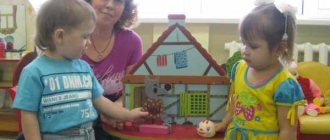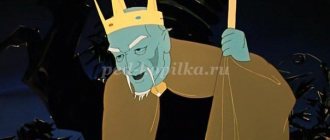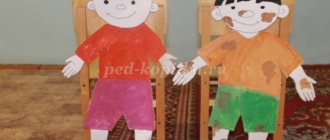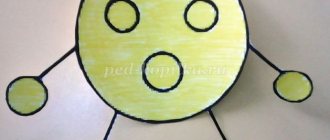Progress of the lesson.
Educator: Today, guys, together with you we will tell and show a familiar fairy tale . Now I will show you a book with bright illustrations of familiar characters, and you tell me what the name of this fairy tale ? – show.
On the pages of this book
A frog, a bunny, and a mouse hid.
They live in ,
The guys are waiting for you to visit.
Children recognize and call it " Teremok "
.
Well done guys, that's right. And (child’s name)
guessed, and
(child’s name)
recognized the mouse and the frog.
And (child’s name)
saw a fox and a bunny.
But look who is this clumsy, club-footed man who loves honey and sucks his paw (Mishka)
- that’s right,
(child’s name)
. Okay, well done.
Now we’ve all sat down comfortably, we’ll listen and watch the fairy tale (after putting the character’s hats on the children’s heads)
.
Educator: There is a teremok in the field , a teremok . He is not short, not high, not tall. Here, across the field, across the field, a mouse runs (directs the child to the tower )
. She stopped at the door and knocked.
The child knocks, saying: pik-pik-pik, who lives in the mansion ?
Educator: There is no one in the mansion , no one answers the mouse. The mouse climbed into the little mansion , began to live there, and began to sing songs:
It’s like the frog is jumping across the field, across the field (directs the child to the little house , stops at the door and screams.
Child: Kva-kva-kva. Who lives in the little house ?
Child: I’m a little mouse, and who are you?
Child: And I'm a frog.
Educator: The frog jumped into the tower . They began to live, live, and sing songs.
A little bunny is running across the field, across the field, stops at the door and knocks (directs the child to the little house )
.
Child: Chuk-chuk-chuk, who lives in the little house ?
The teacher helps children:
And I'm a runaway bunny!
Teacher and children: Come live with us!
And the bunny jumped into the tower .
The teacher repeats the words for the children :
Child: “I am a fox-sister”
Educator: Come live with us. The four of them began to live together. There are already four of us living together. Brother Wolf is knocking on the house.
Child: Who lives in the little house ?
The teacher addresses the children:
Say (child's name)
etc.
Child: I am a gray barrel top - let me into the little house .
Educator: He asks politely to let him in, there is nowhere for the poor to live. They also let the wolf in.
And then a bear wandered in and began to roar.
Child: Who lives in the little house ?
The children, with the help of the teacher, answer: come in, the bear, we have a big mansion , there is enough room for all the animals.
The animals come out of the mansion to play catch-up with the bear and invite the guys.
Well done to our kids,
They deftly ran away from the mouse.
They told us a fairy tale,
Putting everything in its place.
We stood together in a round dance,
The people here are so friendly!
Scenario for staging the fairy tale “Kolobok” in the younger group. Staging the fairy tale “Kolobok” for the younger group. MBDOU Kindergarten No. 6 “Rodnichok” Goal: to develop the creative abilities of children through participation.
Staging of the fairy tale “Teremok” in the second junior group Staging of the fairy tale “Teremok” in the second junior group “Ringing Brook” Purpose: To form in children an interest in games - dramatizations, to form. Staging of the fairy tale "Teremok" in the second junior group. Summary of the staging of the fairy tale "Teremok" in the second junior group. Objectives: 1. To evoke an emotional response in children when performed independently.
Summary of the dramatization of the fairy tale “Teremok” in the second junior group Municipal budgetary preschool educational institution No. 188 “Kindergarten of a general developmental type with priority implementation of activities.
Abstract of the educational activity for speech development “Retelling the fairy tale “Teremok” for the second junior group Goal: to consolidate children’s knowledge of Russian folk tales, to introduce children to mnemonic tables. Objectives: to develop skills, understand the tasks.
Summary of educational activities for speech development “Journey to a Fairy Tale.” Dramatization of the fairy tale “Teremok” in the second junior group. Notes on the development of speech “Journey to a Fairy Tale”. (Dramatization of the fairy tale “Teremok” in the second junior group) Lesson topic: “Travel.
Organization and staging of a Russian folk tale in the second junior group "Terem-Teremok" Organization and staging of a Russian folk tale in the second junior group "Terem-Teremok" Goal: Creating conditions for the development of creativity.
Scenario for dramatizing the fairy tale “Teremok” in the older group (5–6 years old) Good afternoon, dear colleagues! Just yesterday, April 11, my boys and I took part in an inter-district theater art competition.
Photo report “Theatrical performance based on the fairy tale “Teremok” in the second junior group” 05.29.2019. Baskaeva I.M., Gotovtseva O.E. The fairy tale was staged at the end of the school year, as a result of working with children 3-4 years old.
Lesson on speech development in the second junior group. Telling the fairy tale “Teremok” Lesson on speech development in the second junior group. Telling the fairy tale "Teremok". The lesson is conducted with a group of 6-7 people Purpose: Development.
Source
Theatrical activity Game-dramatization of the fairy tale “Teremok” 2nd junior group
Transcript
1 Theatrical activity Game-dramatization of the fairy tale “Teremok” 2nd junior group Purpose: To contribute to the development of children’s ability to reflect some game actions and imitate the actions of characters, convey simple emotional states of characters, using at least one means of expressiveness - facial expressions, gesture, movement (smiles, makes a scared face, shakes his head, waves his arms, etc.); to develop children's interest in games - dramatizations Tasks: Communication to encourage children to actively participate in theatrical games; develop the ability to coordinate actions with other children and heroes of a fairy tale; activate children's speech; improve dialogical speech, reinforce onomatopoeia with familiar animals, reinforce poems about animals; Cognition to consolidate children's knowledge about animals; teach children elements of theatrical activities; develop auditory attention, imagination, interest in performing arts. Fiction continues to introduce children to Russian folk tales. Music to develop a sense of rhythm, emotional responsiveness to music through movement, and to respond to the nature of the music. Methodical techniques: Game, surprise moment, wonderful box, display, comparison, questions, play out. Vocabulary work:
2 Terem-teremok, not low not high, mouse-norushka, frog-croak, bunny-runner, fox-sister, top - gray barrel, clubfooted bear. Preliminary work: Guessing riddles about animals. (The answers are displayed on the screen) Reading the Russian folk tale “Teremok” and a conversation about its content. Imitation and imitation of fairy tale characters (hare - jumps, speaks in a high voice; mouse - runs, squeaks; frog - croaks, jumps, etc.). Singing songs to musical accompaniment. Demonstration of the Teremok tabletop theater. Attributes: Teremok, costumes. Characters: Storyteller, children (mouse, frog, fox, hare, wolf, bear). Materials and equipment: Envelope, letter, tape recorder, characters from the fairy tale “Teremok” (toys). PROGRESS OF THE LESSON: Children enter to the music (audio recording). The storyteller meets them. Storyteller Hello, kids! Girls and boys! Glad to see everyone now. After all, I have been waiting for you for a long time. I am a good storyteller. The time for fairy tales has come. And he calls us to the theater. Can everyone see it, can everyone hear it? Get your ears and eyes ready. Now we'll all go to a fairy tale. The children walked along the path
3 And they found an envelope on the way, And the envelope is not an ordinary one, it’s magical - that’s what it is! What's in the envelope? A mysterious letter, after reading which we will find out what fairy tale we will find ourselves in, and riddles will help us: 1) A little gray ball is rummaging under the floor (mouse) 2) Jumping on the ground, swimming on the water (Frog) 3) A little white one is jumping through the forest - Jump, poke, poke, poke at the snow. (hare) 4) The cunning cheat will deceive everyone cleverly. Everyone in the forest knows her - the red-tailed fox 5) He’s clumsy, shaggy, he sleeps in winter, guys. He can roar loudly Because he is a bear, Grayish, toothy, prowling the field, looking for calves, lambs (Wolf) Guys, what kind of fairy tale do you think this is? That's right, "Teremok" And now I invite you to listen to this fairy tale. The storyteller is standing in a little mansion in a field, A mouse made its way to the door And quietly scratched: Mouse - Who, who lives in the little house? Storyteller No one answers her, The mouse runs into the mansion: - So I can live here and be the mistress of the house.
4 There is a little mansion in the field, Frog Then a frog jumped up, Knocked quietly on the door: - Who, who lives in the little house? Mouse - The mouse lives here, my dear, Come to me, Frog, We will live together with you, Teremok is a spacious house. The storyteller is standing in a field with a little mansion, A hare galloped across the field, He knocked loudly on the door: Hare - Who, who lives in the little house? —- A mouse lives here, little one, Yes, a jumping frog. Come in, Oblique, be bold, It will be more fun together! Game “Bunny” The little white bunny is sitting, He’s moving his ears, Like this, like this, he’s moving his ears It’s cold for the bunny to sit, We need to warm up his little paws Clap, clap, clap, clap It’s cold for the bunny to stand The bunny needs to jump
5 Jump, skok, skok, skok The bunny needs to jump. Someone scared the bunny. The bunny jumped and ran away (on the chairs). The storyteller is standing in a field in a little house, Little Fox ran past, She also knocked on the door: Fox - Who, who lives in the little house? - Mouse, Bunny and Frog. Come in, my friend Fox. The four of us will live, Teremok is a spacious house! Storyteller There is a little mansion in the field, A gray wolf was sneaking across the field, He knocked on the little house: Wolf - Who, who lives in the little house? —- A mouse lives here, little one, Yes, a jumping frog. The Gray Bunny lives and bakes pies with the Fox. We will all be very happy if you become our brother. Just remember the agreement: We live without fights and quarrels. There is a teremok-teremok in the field,
6 Here, shaggy and clubfooted, Bear Potap the Bear came up: “Come on, open the doors, let me into the little house!” The animals answer: “No!” There is no room in the little house. You are too big, bear, go to your home! Here the bear could not resist, roared out of resentment: “They don’t want to let me in, I’ll live on the roof!” He barely climbed onto the roof, the walls creaked loudly, the tower tilted and fell apart over the logs. The animals got out into the wild and went across the open field to scold Clubfoot and look for a new home for themselves. At the end of the dramatization of the fairy tale, the children are asked: “What should we do? What should we do? It is necessary to make children want to build a new house for animals from building material. To the tune of a Russian folk melody, children build a new house for the animals.
7
8
9
Physical education and speech therapy entertainment based on the fairy tale “TEREMOK” in the second junior group
Physical education and speech therapy entertainment based on the Russian folk tale “Teremok”
in the 2nd junior group
Prepared and conducted by: teacher - speech therapist,
Instructor
in physical education
Goal: development of creative imagination, satisfy the natural need of children for communication and movement Objectives: Wellness: - To introduce children to a healthy lifestyle through physical activity: to form a positive attitude towards sports games and exercises Educational: - To form motor skills in children to strengthen them health - train your memory by remembering a fairy tale - strengthen the ability to stick an applique - enrich your vocabulary using nouns and adjectives. Educational: - cultivate friendly relationships between children; the desire to provide help to those who need it, to teach the ability to convey the actions and movements of fairy tale characters, to create a positive emotional mood. Equipment: small and large cubes - 10 pcs. everyone; small and large hoops - 2 pieces; gymnastic arch - 2 pieces; house "Teremok" soft modules, toys (mouse, frog, bunny, fox, wolf, bear). Preliminary work: - reading the fairy tale "Teremok" - conversation about the heroes of the fairy tale - coloring the heroes of the fairy tale Educational areas: - cognitive development - physical development - artistic and aesthetic development - social and communicative development Progress of physical education: Children enter the gym to the sounds of nature. Instructor: Oh, guys, look, something happened here. The house is destroyed and the animals are on the street. Let's ask, maybe you need help? Speech therapist: Guys, listen to what happened here. There was a hut in the forest, A fox, a frog, A mouse, a hare, a gray wolf lived in it - They know a lot about strong friendship. So the bear climbed up to them, and their house immediately broke down. (M. Blinnikova) Guys, what was the name of the house where all these heroes lived together? Children: Teremok Speech therapist: Guys, the animals’ house has collapsed, let’s help them build a new tower. We will remember the fairy tale and help the heroes. Guys, who was the first to live in the tower? (we help if necessary with leading questions, riddle-description) Children: Mouse! Speech therapist (takes a toy - a mouse): To help the mouse, I will turn you into mice too, and you will easily cope with everything. Turn around on one leg and turn into a mouse. What kind of mice are you? small, gray, fast. Instructor: Let's walk like mice (walking on tiptoes) and help the mouse put the grains into bags. Outdoor game “Each grain in its own bag”: small and large cubes and two hoops are laid out around the hall, children crawl under the arc, take one cube at a time, and run to carry the cube into a certain hoop (small ones into a small hoop, and large ones into a large hoop). After the game we put up one part of the tower. Speech therapist: Who came to the tower now? (we help if necessary with leading questions, riddle-description) Children: Frog Speech therapist (takes a toy - a frog): In order to help the frog, you also need to be turned into frogs. Spin around on one leg and turn into frogs. Instructor: Do frogs really like to play?
Outdoor game "Frogs".
In the middle of the hall, a cord is laid out in the shape of a “swamp” circle. The children are standing behind him. The instructor says: Here is a frog along the path, Jumping with its legs outstretched. Kva-kva, kva-kva-kva! Jumps with his legs stretched out. Children, turning one after another, jump on two legs, moving forward in a circle. At the end of the quatrain, the instructor claps his hands - scares the frogs; children jump into the “swamp” circle and squat down. The game is repeated 2-3 times. After completing the task, we install part of the house.
Speech therapist: Who came to the tower next? (we help if necessary with leading questions, riddle-description) Children: Hare Speech therapist (takes a toy - a hare): In order to help the bunny, you need to be transformed again. Spin around on one leg and turn into a bunny. Instructor: Guys, the bunny loves to dance! Dance “The bunnies danced in the clearing” (author A. Chugaikina).
After completing the task, we install part of the house. Speech therapist: Who came to the tower now? (we help if necessary with leading questions, riddle-description) Children: Fox Speech therapist (takes a toy - a fox): Spin on one leg and turn into a fox.
Speech therapist: I’ll give you more building material if you affectionately name all the heroes of the fairy tale. Children affectionately call the heroes of the fairy tale. After completing the task, we install part of the house. Speech therapist: Who came to the tower next? (we help if necessary with leading questions, riddle-description) Children: Wolf Speech therapist (takes a toy - a wolf): Spin around on one leg and turn into a wolf cub. Guys, what are wolves? gray, toothy. Instructor: And wolves love to play with bunnies. Let's play with you too? The outdoor game “Hares and the Wolf” is played. Children pretend to be hares, some of the children are wolves. On one side of the site for hares, houses or one common house are marked. The wolf is hiding on the opposite side in the “ravine”. In accordance with the text, the hares jump out of the houses, run around the site, then jump on two legs, then sit down and nibble grass, saying the words:
The hares gallop, hop, hop, hop. To the green meadow. They pinch the grass, eat it, listen quietly, Is there a wolf coming?
As soon as an adult says the word “wolf,” he jumps out of the ravine and runs after the hares, trying to catch (touch) them. The hares run away to their houses. The wolf takes the caught hares to his ravine. By agreement, after the wolf catches 2-3 birds with one stone, another child is chosen to play the role of the wolf. The game repeats itself.
After completing the task, we finish building the house. Speech therapist: Who came to the tower next? (we help if necessary with leading questions, riddle-description) Children: Bear Speech therapist (takes a toy - a bear): Spin around on one leg and turn into a bear cub. Guys, what kind of bears are they? big, brown, furry. Guys, let's put all the animals together so that they live together and have fun together.
Application “Animals in the mansion”
We consider the overall work, thank and treat the children on behalf of the animals.
Open lesson in the second junior group. Game-dramatization of the Russian folk tale “Teremok”
Dmitrieva Elena
Open lesson in the second junior group. Game-dramatization of the Russian folk tale “Teremok”
Municipal budget preschool
d/s " Teremok "
Open lesson in the second junior group
Dramatization game
Russian folk tale " Teremok "
.
Prepared and conducted:
Teacher Dmitrieva E.V.
Goal: to create a sustainable interest in theatrical activities through the dramatization of the Russian folk tale “ Teremok ”
.
Objectives: develop cognitive interest , promote free and relaxed behavior when speaking, encourage improvisation through expressive movements and intonation. Expand your active vocabulary, form emotional expressiveness of speech. To foster in children friendly relationships, goodwill, a desire to help, and to help create a joyful emotional mood in children.
Materials and equipment: hats-masks of fairy tale , decoration trees, mansion , path, magic box, cards with riddles.
Preliminary work: reading a fairy tale , looking at illustrations based on the fairy tale “ Teremok ”
, discussion of the content
of the fairy tale , asking riddles, showing a tabletop theater.
Vocabulary work: mouse-norushka, frog-frog, bunny-runner, fox-sister, spinning top-gray barrel, clubfooted bear.





